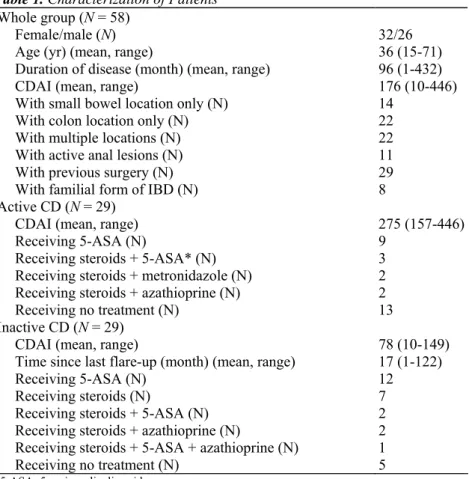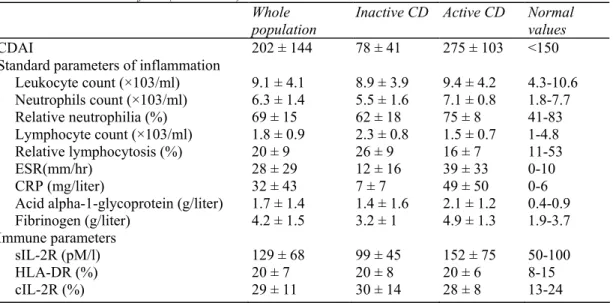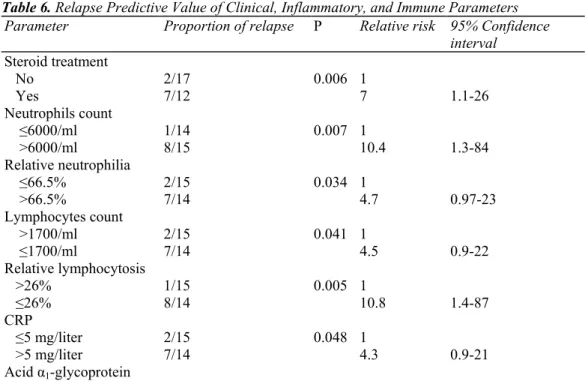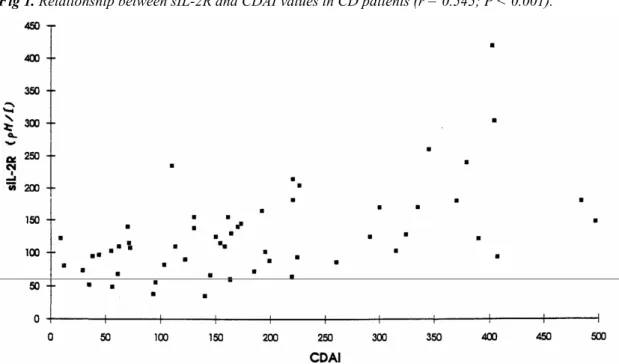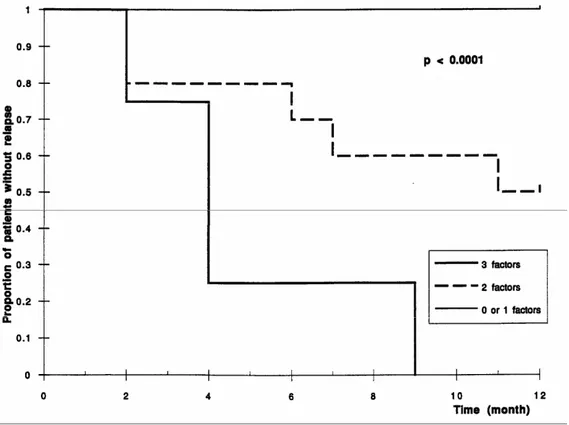Soluble Interleukin-2 Receptor in Crohn's Disease
Assessment of Disease Activity and Prediction of Relapse
*E. LOUIS, MD, J. BELAICHE, PhD, C. VAN KEMSEKE, MD, N. SCHAAF, P. MAHIEU, PhD, and J.Y. MARY
From the Departments of Gastroenterology and Immunology, CHU of Liège, Belgium; and INSERM U263#, Université Paris 7, Paris, France.
Abstract
In Crohn's disease, the activity of the disease is sometimes difficult to evaluate and the evolution of the disease is difficult to predict. The soluble interleukin-2 receptor serum level has been reported to correlate with clinical activity of the disease and with mucosal immune activation. We compared serum soluble interleukin-2 receptor to classical inflammatory markers and other immune parameters in the assessment of clinical disease activity and prediction of relapse in patients with Crohn's disease. Soluble interleukin-2 receptor serum levels correlated well with the Crohn's disease activity index, and multivariate analysis showed that this correlation was independent of the other inflammatory and immune markers. The correlation was not greater, however, than that between some inflammatory markers, such as ESR, and Crohn's disease activity index. Longitudinal follow-up showed that a high soluble interleukin-2 receptor serum level was highly predictive of relapse. Multivariate analysis showed that the soluble interleukin-2 recepteur serum level was complementary to other inflammatory and clinical markers in the prediction of relapse of disease. We conclude that soluble interleukin-2 receptor is of use in monitoring Crohn's disease, particularly in prediction of relapse.
KEYWORDS : Crohn's disease ; interleukin-2 receptor ; disease activity ; relapse prediction.
Crohn's disease (CD) is a chronic relapsing inflammatory bowel disease of unknown etiology. It is often difficult to assess its activity and to predict the evolution of the disease and particularly disease relapse. CD is
characterized by a chronic transmural inflammation, and the immune system seems to be involved in the pathogenesis of the disease (1). In addition to symptoms, immune and inflammatory markers can be useful for monitoring the disease.
Inflammatory markers have extensively been studied in CD and correlate with clinical markers of disease activity (2-4). Moreover some studies have suggested that they have value in the prediction of disease relapse (5-7). In recent years, new immune markers have been evaluated. Soluble interleukin-2 receptor (sIL-2R) is particularly interesting in assessment of mucosal immune activity. In normal subjects, the sIL-2R serum level correlates with sIL-2R production by the lamina propria mononuclear cells in culture (8). Moreover, in CD, the sIL-2R serum level is increased in active disease (4, 9-11) and correlates with the sIL-2R level in supernatants of lamina propria mononuclear cells in culture (8).
The list of new inflammatory and immune markers is growing, and it is important to establish whether a newly proposed marker really makes a unique contribution to assessment of disease activity and evolution. The aims of our study were twofold. First, we compared sIL-2R to classical inflammatory and immune markers in assessment of disease activity in a group of patients with CD. Second, by longitudinal follow-up of patients, we compared the value of sIL-2R to classical inflammatory and immune markers in prediction of time-to-relapse.
MATERIALS AND METHODS
Patients. Fifty-eight consecutive patients with a diagnosis of CD based on standard criteria were studied. Patients characteristics and clinical features are shown in Table 1.
Study Design. All patients included in the study underwent assessment of clinical indices in addition to a variety of inflammatory markers and immune parameters. Of the initial study population, the 29 patients with inactive disease were then followed longitudinally over a 12-month period with clinical assessment at three-month
*
intervals. Disease relapse was defined as a Crohn's disease activity index (CDAI) greater than 150 with an increase of 100 or more over the initial value.
Study Parameters. In addition to clinical assessment and calculation of CDAI, different laboratory parameters were measured. The total white cell count and differential, total neutrophil and lymphocyte counts, erythrocyte sedimentation rate (ESR), C-reactive protein (CRP), fibrinogen, and acid α1-glycoprotein were determined using routine procedures. Blood lymphocyte expression of HLA-DR and cellular receptor for interleukin 2 (cIL-2R) were measured by direct immunofluorescence staining of cell surface and flow cytometry analysis. The antibody used for cIL-2R detected the α-chain (p55) of the receptor. Serum levels of sIL-2R were measured using a commercial double-antibody sandwich enzyme-linked immunosorbent assay detecting the α-chain (p55) of the receptor (Boehringer Manheim Biochemical).
Statistical Analysis. The relationships between CDAI and the various laboratory parameters were evaluated using the Pearson correlation coefficient. A forward stepwise multiple linear regression analysis was then performed to determine if the different biological variables were independently correlated with the CDAI. The CDAI was the dependent variable, and the laboratory parameters were designated as independent variables. Any skewed variable was transformed (log) to normalize its distribution before further analysis.
To assess the data from the patients who were followed up longitudinally, time-to-relapse curves were estimated by the Kaplan-Meier method. The time-to-relapse predictive value of each independent clinical, inflammatory, or immune parameter was tested by using the proportional hazard model (Cox model) providing an estimate of the relative risk of relapse (RR: mean, 95% confidence interval). The continuous variables were dichotomized on logical grounds, using usual limits, or on established basis, using the median. Stepwise multivariate analysis with the Cox model was used to select the best combination of parameters for time-to-relapse prediction and to provide different prognostic groups.
Table 1. Characterization of Patients Whole group (N = 58)
Female/male (N) 32/26
Age (yr) (mean, range) 36 (15-71)
Duration of disease (month) (mean, range) 96 (1-432)
CDAI (mean, range) 176 (10-446)
With small bowel location only (N) 14
With colon location only (N) 22
With multiple locations (N) 22
With active anal lesions (N) 11
With previous surgery (N) 29
With familial form of IBD (N) 8
Active CD (N = 29)
CDAI (mean, range) 275 (157-446)
Receiving 5-ASA (N) 9
Receiving steroids + 5-ASA* (N) 3
Receiving steroids + metronidazole (N) 2
Receiving steroids + azathioprine (N) 2
Receiving no treatment (N) 13
Inactive CD (N = 29)
CDAI (mean, range) 78 (10-149)
Time since last flare-up (month) (mean, range) 17 (1-122)
Receiving 5-ASA (N) 12
Receiving steroids (N) 7
Receiving steroids + 5-ASA (N) 2
Receiving steroids + azathioprine (N) 2
Receiving steroids + 5-ASA + azathioprine (N) 1
Receiving no treatment (N) 5
RESULTS
The bioclinical data of the studied sample is shown in Table 2. There were significant correlations between CDAI and all the laboratory parameters of inflammation (Table 3). The highest correlation values were obtained with ESR, and serum level of 2R (Figure 1). There were significant correlations between serum level of sIL-2R and all laboratory parameters of inflammation, with the exception of acid α1-glyeoprotein (Table 4). The highest correlation value was obtained with ESR. The serum level of sIL-2R did not correlate with blood lymphocytes expression of HLA-DR or CIL-2R. There were no significant correlations between blood lymphocyte expression of HLA-DR or CIL-2R and laboratory parameters of inflammation. The multiple
stepwise analysis with CDAI as the dependent variable showed that ESR, sIL-2R, and the relative lymphocytosis had independent correlations with CDAI. The multiple correlation at each step, and the P value for these
correlations are shown in Table 5.
All 29 patients with initially inactive disease were followed up for 12 months, over which time nine patients relapsed. For these patients, the time-to-relapse was 5 ± 3 months (mean ± SD).Parameters predictive of time to relapse are shown in Table 6. Parameters that had no significant time-to-relapse predictive value included: localization of the disease, anal lesions, duration of the disease, time since first symptoms, age, previous surgery, familial form, time since the previous flare-up (different times were tested: 3, 6, and 12 months), treatment with 5-ASA, treatment with azathioprine, CDAI, leukocyte count, ESR, fibrinogen and peripheral blood lymphocyte expression of HLA-DR or cIL-2R. The time-to-relapse curve according to the sIL-2R serum level is shown in Figure 2.
The stepwise multivariate analysis selected two possible models. In the first model, three variables were
successively selected: the relative lymphocytosis <26%, sIL-2R serum level >95 pM/liter, and the duration of the disease >5 years (P < 0.0001). In the second model, four variables were selected: sIL-2R serum level >95 pM/liter, the duration of the disease >5 years, the time since the previous flare-up <3 months, and the absolute neutrophilia >6000/ml (P < 0.0001). The proportion of patients remaining in remission over a one-year period depending on the number of unfavorable prognostic parameters present is shown in Figures 3 and 4. In the first model, the observed proportion of relapse at 12 months was 0% if 0 or 1 risk factor was present (N = 15), 50% with two risk factors (N = 10), and 100% with three risk factors present (N = 4). In the second model, the observed proportion of relapse at 12 months was 0% if 0 or 1 risk factor was present (N = 12), 20% with two risk factors (N = 11), and 100% with three or four risk factors (N = 6).
Table 2. Bioclinical Profiles (Mean ± SD) Whole population
Inactive CD Active CD Normal values
CDAI 202 ± 144 78 ± 41 275 ± 103 <150
Standard parameters of inflammation
Leukocyte count (×103/ml) 9.1 ± 4.1 8.9 ± 3.9 9.4 ± 4.2 4.3-10.6 Neutrophils count (×103/ml) 6.3 ± 1.4 5.5 ± 1.6 7.1 ± 0.8 1.8-7.7 Relative neutrophilia (%) 69 ± 15 62 ± 18 75 ± 8 41-83 Lymphocyte count (×103/ml) 1.8 ± 0.9 2.3 ± 0.8 1.5 ± 0.7 1-4.8 Relative lymphocytosis (%) 20 ± 9 26 ± 9 16 ± 7 11-53 ESR(mm/hr) 28 ± 29 12 ± 16 39 ± 33 0-10 CRP (mg/liter) 32 ± 43 7 ± 7 49 ± 50 0-6
Acid alpha-1-glycoprotein (g/liter) 1.7 ± 1.4 1.4 ± 1.6 2.1 ± 1.2 0.4-0.9
Fibrinogen (g/liter) 4.2 ± 1.5 3.2 ± 1 4.9 ± 1.3 1.9-3.7
Immune parameters
sIL-2R (pM/l) 129 ± 68 99 ± 45 152 ± 75 50-100
HLA-DR (%) 20 ± 7 20 ± 8 20 ± 6 8-15
Table 3. Correlations (r) Between Inflammatory or Immune Parameters and Crohn's Disease Activity Index
Inflammatory and immune parameters r P
Leukocyte count 0.078 0.580 Neutrophil count 0.325 0.012 Relative neutrophilia 0.365 0.009 Lymphocyte count -0.412 0.005 Relative lymphocytosis -0.461 0.001 ESR 0.613 0.001 CRP 0.412 0.003 Acid (α1-glycoprotein 0.454 0.008 Fibrinogen 0.528 0.001 sIL-2R 0.545 0.001 HLA-DR 0.008 0.961 cIL-2R -0.136 0.472
Table 4. Correlations Between Inflammatory Parameters and sIL-2R Serum Level
Inflammatory parameters r P Leukocyte count 0.311 0.018 Neutrophil count 0.294 0.037 Relative neutrophilia 0.280 0.040 Lymphocyte count -0.382 0.005 Relative lymphocytosis -0.390 0.004 ESR 0.429 0.002 CRP 0.348 0.011 Fibrinogen 0.286 0.042 Acid α1-glycoprotein 0.111 0.519
Table 5. Multivariate Analysis with CDAI as Dependent Parameter
Step Variable entered Model correlation (R) P
1 ESR (log) 0.358 0.001
2 SIL-2R 0.492 0.03
3 relative lymphocytosis 0.530 0.092
Table 6. Relapse Predictive Value of Clinical, Inflammatory, and Immune Parameters
Parameter Proportion of relapse P Relative risk 95% Confidence
interval Steroid treatment No 2/17 0.006 1 Yes 7/12 7 1.1-26 Neutrophils count ≤6000/ml 1/14 0.007 1 >6000/ml 8/15 10.4 1.3-84 Relative neutrophilia ≤66.5% 2/15 0.034 1 >66.5% 7/14 4.7 0.97-23 Lymphocytes count >1700/ml 2/15 0.041 1 ≤1700/ml 7/14 4.5 0.9-22 Relative lymphocytosis >26% 1/15 0.005 1 ≤26% 8/14 10.8 1.4-87 CRP ≤5 mg/liter 2/15 0.048 1 >5 mg/liter 7/14 4.3 0.9-21 Acid α1-glycoprotein
≤1.1 g/liter 2/15 0.03 1
>1.1 g/liter 7/14 4.9 1.01-24
SIL-2R
≤95 pM/liter 1/14 0.008 1
>95 pM/liter 8/15 9.9 1.2-79
Fig 1. Relationship between sIL-2R and CDAI values in CD patients (r = 0.545; P < 0.001).
Fig 3. Time to relapse over one year depending on the number of unfavorable prognostic factors at inclusion (first model): relative lymphocytosis <25.5%, sIL-2R serum level >95 pM/liter, and a duration of the disease >5 years.
Fig 4. Time to relapse over one year depending on the number of unfavorable prognostic factors at inclusion (second model): sIL-2R serum level >95 pM/liter, duration of the disease >5 years, time since the last flare-up <3 months, neutrophil count >6000/ml.
DISCUSSION
Our results show good correlation among CDAI, laboratory parameters of inflammation, and serum levels of sIL-2R, but poor or no correlation with blood lymphocyte parameters of immune activation. Other investigators have found higher serum levels of sIL-2R in CD than in controls (4, 9-12), but the correlation between clinical activity indices and sIL-2R was not always significant (9, 10). Discrepancies may be explained by the use of different indices of clinical activity, by small numbers of patients in different studies, or by differences in the relative number of patients with active or inactive disease. One recent study has shown that in CD the majority of serum sIL-2R was probably produced by lamina propria mononuclear cells (8). Furthermore, in another study, higher levels of sIL-2R were found in samples from the mesenteric vein compared with those from the peripheral vein (9). Thus, sIL-2R serum levels seem to reflect mucosal immune activation in CD.
The correlation between sIL-2R and inflammatory parameters remains controversial. Some studies found a significant correlation (4, 11, 12) but others have not (9). We found a significant correlation between sIL-2R and ESR, CRP, and fibrinogen. Once again, these discrepancies may be explained by the same reasons as given for the different findings with the CDAI. Blood lymphocyte expression of HLA-DR and cIL-2R seems to be increased in CD (13), but did not correlate with CDAI and laboratory parameters of inflammation in our study. The increase in expression of HLA-DR and cIL-2R is probably a secondary phenomenon that is not closely linked to the activity of the disease.
The stepwise multiple linear regression analysis with CDAI as the dependent parameter selected ESR, relative lymphocytosis, and sIL-2R. These three parameters are thus independently correlated with CDAI. These results suggests that these three parameters are complementary in the assessment of clinical disease activity. In practice, these findings are probably of limited use as, in the majority of cases, clinical evaluation of patients with active disease is usually sufficient.
The results of our longitudinal observations suggest that sIL-2R/some inflammatory markers, and some clinical characteristics may have value in the prediction of relapse in patients with inactive disease. The predictive value of some inflammatory markers (CRP, acid α1-glycoprotein, α2-globulin, and ESR) has already been described (6, 7). The predictive value of a high level of sIL-2R has not been previously reported. Persisting biological
abnormalities in quiescent patients may indicate persisting immune and inflammatory activity that may lead, after a variable time, to clinical manifestations. In particular, a high serum level of sIL-2R may indicate persistent activation of mucosal T lymphocytes (8). In some patients, the time-to-relapse was quite long (>5 months), but the clinical relapse is a relatively complex phenomenon that may not be entirely dependent on the mucosal immune and inflammatory process (14-16). Treatment with corticosteroids also had significant time-to-relapse predictive value. This may be explained by the fact that patients with corticosteroid therapy were those with a short duration of remission or with difficult disease requiring corticosteroids to maintain remission, and thus being more prone to relapse. The multivariate analysis showed that sIL-2R was complementary to the relative lymphocytosis and the duration of the disease (first model) or to the duration of the disease, the time since the last flare-up, and the absolute neutrophilia (second model) for relapse prediction. The neutrophilia was significantly higher in patients treated with corticosteroids than in the others (data not shown). Its selection in the second model may thus partly be due to the propensity to relapse in patients treated with corticosteroids. For this reason, the second model, despite its higher statistical power, may be less interesting for patients with other treatments. The duration of the disease and the time since the last flare-up, although not having an individual significant time-to-relapse predictive value, became useful in association with immune and inflammatory parameters. A large previous study had already shown the potential usefulness of such clinical parameters, in particular of the interval since previous flare-up, in predicting relapse in quiescent CD (17).
In conclusion, sIL-2R is complementary to inflammatory markers and clinical characteristics in the assessment of disease activity in CD. The clinical usefulness of such an immune marker in active disease remains
controversial and has to take into account its cost. On the other hand, sIL-2R has a time-to-relapse predictive value in quiescent patients and is also complementary to clinical and inflammatory parameters for relapse prediction. With this in mind, sIL-2R could be useful in specific therapeutic strategies, such as in selecting patients for enrollment in therapeutic trials of maintenance of remission in CD.
REFERENCES
1. Strober W, James SP: The immunologic basis of inflammatory bowel disease. J Clin Immunol 6:415-432, 1986
2. Campbell CA, Walker-Smith JA, Hindocha P, et al: Acute phase proteins in chronic inflammatory bowel disease in childhood. J Pediatr Gastroenterol Nutr 1:193-200, 1982
3. Vesparget H, Biemond I, Waterman I: Biochemical parameters as activity index in Crohn's disease. International congress of Gastroenterology, Lisbon, 1984, p 298, (abstract)
4. Williams AJK, Symons JA, Watchet K, Duff GW: Soluble interleukin-2 receptor and disease activity in Crohn's disease. J Autoimmun 5:251-259, 1992
5. Andre C, Descos I, Vignal J, Gillon J: C-reactive protein as predictor of relapse in asymptomatic patients with Crohn's disease. Scott Med J 28:26-29, 1983
6. Brignola C, Campieri M, Bazzocchi G, Farruggia P, Tragnone A, Lanfranchi GA: A laboratory index for predicting relapse in asymptomatic patients with Crohn's disease. Gastroenterology 91:1490-1494, 1986
7. Brignola C, Iannone P, Belloli C, De Simone G, Bassein L, Gionchetti P, Belluzzi A, Campieri M, Barbara L: Prediction of relapse in patients with crohn's disease in remission: a simplified index using laboratory tests, enhanced by clinical characteristics. Eur J Gastroenterol Hepatol 6:955-961, 1994
8. Matsuura T, West GA, Klein JS, Ferraris L, Fiocchi C: Soluble interleukin 2 and CD8 and CD4 receptors in inflammatory bowel disease. Gastroenterology 102:2006-2014, 1992
9. Mahida YR, Gallagher A, Kurlak L, Hawkey CJ: Plasma and tissue interleukin-2 receptor levels in inflammatory bowel disease. Clin Exp Immunol 82:75-80, 1990
10. Brynskov J, Tvede N: Plasma interleukin-2 and a soluble/shed interleukin-2 receptor in serum of patients with Crohn's disease. Effect of cyclosporin. Gut 31:795-799, 1990
11. Mueller C, Knoflach P, Zielinski CC: T-cell activation in Crohn's disease. Increased levels of soluble interleukin-2 receptor in serum and in supernatants of stimulated peripheral blood mononuclear cells. Gastroenterology 98:639-646, 1990
12. Crabtree JE, Juby LD, Heatley RV, Lobo AJ, Bullmore DW, Axon ATR: Soluble interleukin-2 receptor in Crohn's disease: relation of serum concentrations to disease activity. Gut 31:1033-1036, 1990
13. Raedler A, Fraenkel S, Klose G, Seyfarth K, Thiele HG: Involvement of the immune system in the pathogenesis of Crohn's disease. Expression of the T9 antigen on peripheral immunocytes correlates with the severity of the disease. Gastroenterology 88:978-983, 1985 14. Rutgeerts P, Geboes K, Vantrappen G, Beyls J, Kerremans R, Hiele M: Predictability of the postoperative course of Crohn's disease. Gastroenterology 99:956-963, 1990
15. Modigliani R, Mary JY, Simon JF, et al: Clinical biological and endoscopic picture of attacks of Crohn's disease; evolution on prednisolone. Gastroenterology 98:811-818, 1990
16. Cellier C, Sahmoud T, Froguel E, et al: Correlations between clinical activity, endoscopic severity, and biological parameters in colonic or ileocolonic Crohn's disease. A prospective multi-centre study of 121 cases. Gut 35:231-235, 1994
17. Sahmoud T, Modigliani R, Gendre JP, Mary JY: Predicting relapse in quiescent cronh's disease patients: index construction and cross-validation. Gastroenterology 106:A1048, 1994 (abstract)
